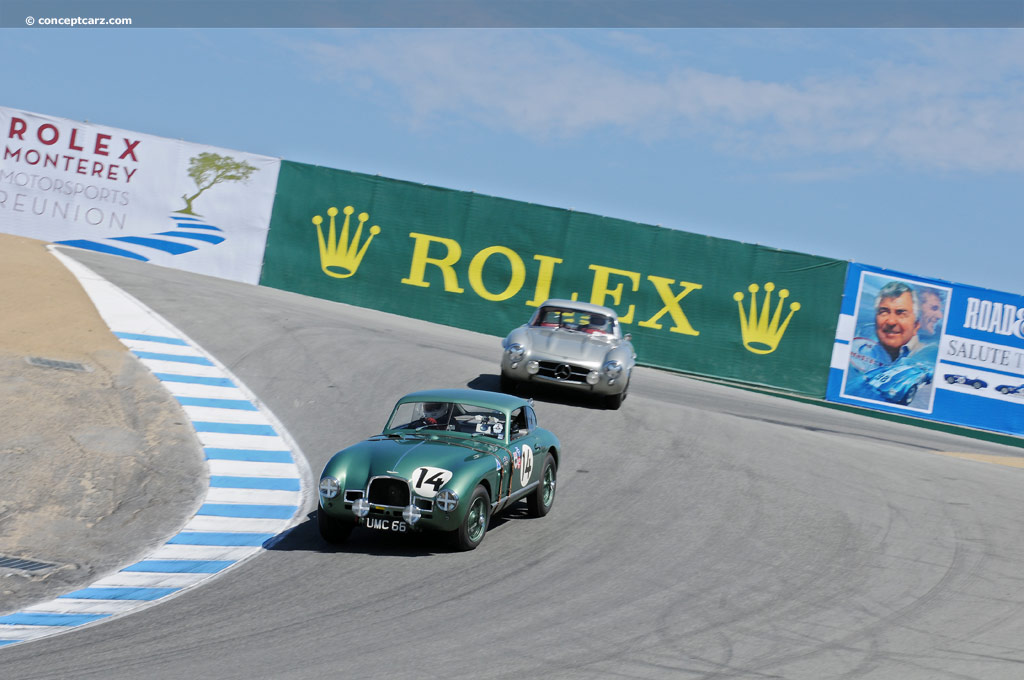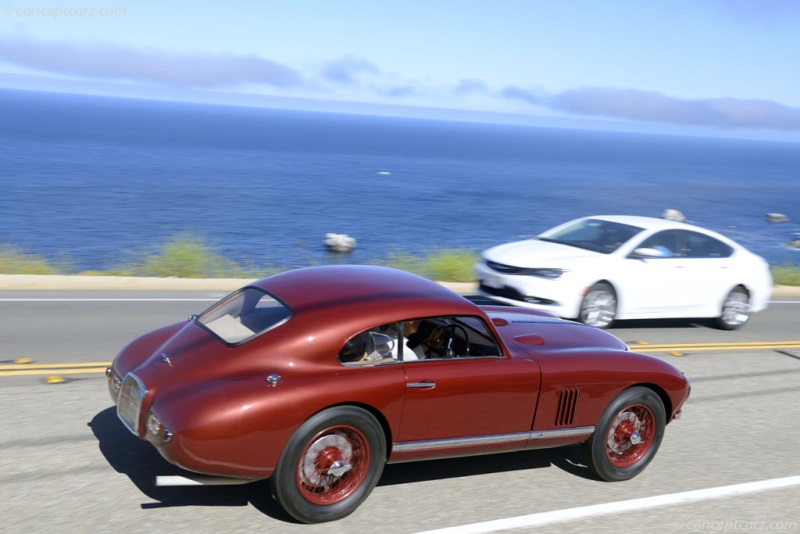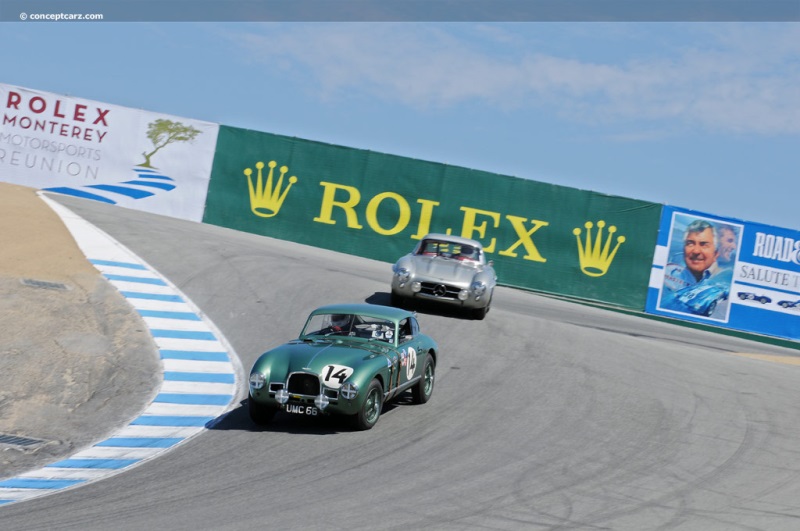During the pre-World War II era, the Aston Martin was guided initially by Lionel Martin and Robert Bamford. They joined forces in 1912 as Bamford & Martin selling cars made by Singer, and when they decided to make their own vehicles, they wore the name 'Aston Martin.' 'Aston' was in reference to Martin's racing endeavors at Aston Hill near Aston Clinton. It was far more than just a namesake, as it would become the venue for many defining moments in the early years of the marque. Lionel Martin competed with his home-tuned Singer specials, later switching to cars of his own design, and forever cementing a lasting ethos of sporting performance that defined the British brand. 
Coupe
Chassis #: LML/49/3
View info and historyThe first Aston Martin was produced in March 1915 but production was soon halted due to the outbreak of World War I. Bamford left in 1920 and in 1924 the bankrupt Bamford & Martin company was acquired by Dorothea, Lady Charnwood, who put her son John Benson on the board. The early Aston-Martins (the hyphen is correct for the period) built by Robert Bamford and Lionel Martin quickly established a reputation for their durability and performance. Motorsports distracted the company from the business of building cars for sale, and approximately sixty-one examples were sold by 1925 when the company underwent the first of what would be many changes of ownership. Control of the business passed to Bill Renwick, Augustus (Bert) Bertelli and investors including Lady Charnwood. Under their guidance, the company was renamed Aston Martin Motors, new premises were acquired at the former Whitehead Aircraft Limited Hanworth works in Feltham, and the foundation was laid for proper series production. These 'new generation' of Aston Martins made their debut in 1927 at the London Motor Show at Olympia. Competition, however, would remain a valuable part of the company and would achieve a class victory and 5th place overall finish in the 1931 Le Mans race. The economic recession of the 19930s brought more financial instability for the company, and in 1932 Aston Martin was rescued by Lance Prideaux Brune before passing it on to Sir Arthur Sutherland. 
Coupe
Chassis #: LML/49/3
View info and historyDuring World War II, the company produced aircraft components in support of the war effort.Post World War II
When peacetime resumed, Aston Martin was once again saved from obscurity, this time by privately owned Huddersfield gear and machine tools manufacturer David Brown Limited. A few months later, David Brown acquired Lagonda's business (sans the factory) for its 2.6-liter W.O. Bentley-designed engine. This basic engine design would be utilized through 1959, powering Aston Martin's DB2, DB2/4, and DB Mark III road cars, as well as the DB3 and DB3S sports racers. Before the road-going versions were introduced to the street, the first DB2 competition cars made their debut at the 24 Hours of Le Mans in 1949. The Lagonda twin-cam, six-cylinder engine was installed in a shortened Aston Martin '2-liter Sport' chassis and clothed with Frank Freely's sports-tourer bodywork, giving birth the DB2 era. Production of the Le Mans prototype was announced in April of 1950, followed in 1953 by the DB2/4, the DB2/4 MKII in 1955, the DB Mark III in 1957, the DB4 in 1958, the DB5 in 1963, DB6 in 1965, and the DBS in 1967. The DB Mark II used an evolution of the Bentley-designed 2.9-liter Lagonda straight-6 engine (redesigned by Tadek Marek) and the DB4 was equipped with a 3.7-liter DOHC straight-6 designed by Marek.Mechanical Specification
The Lagonda 2.6-liter, dual overhead cam, straight-six engine was more powerful than the 2.0-liter, pushrod straight-4 powering the previous Aston Martin 2-Litre Sports. Much of the Lagonda's engine design was courtesy of William (Willie) Watson under the supervision of W.O. Bentley. In its original guise, it had a 3.07-inch (78mm) bore and a 3.543-inch (90 mm) stroke. With a cast-iron block and head and dual SU carburetors installed, the 2.6-liter unit developed approximately 105 horsepower. A David Brown four-speed manual gearbox sent power to the rear wheels.
Coupe
Chassis #: LML/49/3
View info and historyEarly testing with the six-cylinder engine revealed a top speed approaching 120 mph and a zero-to-sixty mph time of 11.2 seconds.Larger carburetors, higher compression ratio pistons (8.16:1) and a larger inlet camshaft became available in April of 1950 in 'Vantage' configuration, offering 125 horsepower. Since the British market during the early 1950s was limited to 72-octane fuel, the higher compression ratio was unsuitable for this market. The Aston Martin 2-Litre Sports tube-frame chassis designed by Claude Hill was shortened to a wheelbase of 99 inches and a length of 162.5 inches. The independent front suspension arrangement owed much to Claude Hill's prewar Atom, and the rear setup received new coil springs. At all four corners were hydraulic Alfin drum brakes.Body Design
Part of David Brown's Lagonda acquisition included the design team which included Frank Feeley. Mr. Feeley was tasked with designing the sports-tourer (fastback coupe) coachwork for the latest Aston Martin model. He remained Aston Martin's in-house designer up until 1956. The aggressive, streamlined bodywork was constructed using lightweight aluminum panels. They had a single-piece bonnet (hood) hinged at the front, and a small top-hinged lid at the rear of the fixed-head coupe (FHC) which allowed access to the spare wheel. Behind the front seats was space for the luggage and was accessible only from the interior of the car.
Coupe
Chassis #: LML/49/4
Engine #: LB6/49/29
View info and history
Auction entries : 1The earliest production DB2 models to leave the factory floor had a three-part grille and a substantial slatted vent behind each front wheel which gave rise to the 'Washboard' nickname. After an initial run of 49 cars, the design was simplified and thereafter the side vent was deleted and the three-piece grille was replaced by a single unit.Production
Aston Martin introduced the DB2 in April of 1950 at the New York Auto Show and production would continue through April of 1953, with a total of 411 examples being built. Of those, approximately 102 examples were Drophead Coupes (DHC) which were introduced later in 1950. Competition
Aston Martin raced three pre-production cars (chassis LMA/49/1, LMA/49/2, and LML/49/3) at the first postwar 24 Hours of LeMans in June 1949 under the leadership of team manager John Wyer and newly-hired drivers, including Jack Fairman, George Abecassis, Lance Macklin, and Reg Parnell. A fourth example (chassis LML/49/4) was built for Mr. Brown's personal use. These four prototypes were manufactured by Aston Martin Lagonda Ltd. in Feltham through the winter and spring of 1948 through 1949. According to factory records, these new Aston Martin competition cars were referred to as the DB MK II. All four of the DB Mk IIs were registered on April 26, 1949. The three Aston Martin Works racing cars were registered UMC 64, UMC 65, and UMC 66, and wore identical exterior paint schemes of Almond Green paint with green canvas upholstery. David Brown's personal car was registered UMC 272 and painted maroon and trimmed with beige leather.
Coupe
Chassis #: LML/49/4
Engine #: LB6/49/29
View info and history
Auction entries : 1Two of the LeMans cars used the tried-and-true four-cylinder Aston Martin 2-litre powerplant while one received the Lagonda straight-6. Leslie Johnson drove the Lagonda-powered car and made it six laps before being forced to retire due to overheating caused by the failure of the water pump. Pierre Marechal was fatally injured while driving one of the 2-liter cars; he was in 4th place and was running without brakes when it crashed twenty-two hours into the race. Arthur Jones and Nick Haines drove the other 2-litre car to a 7th-place finish.A month after the Le Mans race, Leslie Johnson and Charles Brackenbury drove the Lagonda car to a 3rd place finish in the Spa 24-hour race. A 2-litre car driven by Nick Haines and Lance Macklin finished 5th overall. Aston Martin returned to LeMans in 1950 with a trio of DB2 models (LML/50/7, 50/8, and 50/9) all powered by the Lagonda engine. George Abecassis and Lance Macklin placed fifth and were immediately followed by Brackenbury and Reg Parnell in sixth. This gave Aston Martin a 1st and 2nd place finish in the 3-liter category. The factory Works team continued to race the DB2 in Europe through 1951, including another visit to LeMans where Macklin and Eric Thompson placed 3rd overall and Abecassis and Brian Shawe-Taylor 5th.
Coupe
Chassis #: LML/49/3
View info and historyAt the inaugural Sebring race meeting in December of 1950, Briggs Cunningham finished 2nd in class in a DB2. His car was LML 50/21 - the first DB2 with the 'Vantage' specification. The Aston Martin DB2/4 Mark I and Mark II
In 1953, Aston Martin introduced the DB2/4, which was based on the DB2, and fitted with repositioned headlights, larger bumpers, and a wraparound windscreen. Beneath the bonnet was the Lagonda straight-6 engine in Vantage trim and delivered approximately 125 horsepower (displacement later grew to 2.9-liters and output to 140 hp). A total of 565 Mark I examples were produced including 102 Drophead Coupes. The Mark II followed in 1955 and had small tailfins, additional chrome trim, and bubble-type tail lights. An optional large-valve, high-compression engine was offered which brought horsepower to 165 bhp. Before the introduction of the Mark III, Aston Martin had produced 199 examples of the Mark II including 34 which received new 2-seat Fixed Head Coupe (FHC) bodywork. Three examples were bodied by Carrozzeria Touring in Italy in Spider configuration.
by Daniel Vaughan | Jan 2023

Coupe
Chassis #: LML/49/3
View info and history

Coupe
Chassis #: LML/49/3
View info and history
When peacetime resumed, Aston Martin was once again saved from obscurity, this time by privately owned Huddersfield gear and machine tools manufacturer David Brown Limited. A few months later, David Brown acquired Lagonda's business (sans the factory) for its 2.6-liter W.O. Bentley-designed engine. This basic engine design would be utilized through 1959, powering Aston Martin's DB2, DB2/4, and DB Mark III road cars, as well as the DB3 and DB3S sports racers. Before the road-going versions were introduced to the street, the first DB2 competition cars made their debut at the 24 Hours of Le Mans in 1949. The Lagonda twin-cam, six-cylinder engine was installed in a shortened Aston Martin '2-liter Sport' chassis and clothed with Frank Freely's sports-tourer bodywork, giving birth the DB2 era. Production of the Le Mans prototype was announced in April of 1950, followed in 1953 by the DB2/4, the DB2/4 MKII in 1955, the DB Mark III in 1957, the DB4 in 1958, the DB5 in 1963, DB6 in 1965, and the DBS in 1967. The DB Mark II used an evolution of the Bentley-designed 2.9-liter Lagonda straight-6 engine (redesigned by Tadek Marek) and the DB4 was equipped with a 3.7-liter DOHC straight-6 designed by Marek.Mechanical Specification
The Lagonda 2.6-liter, dual overhead cam, straight-six engine was more powerful than the 2.0-liter, pushrod straight-4 powering the previous Aston Martin 2-Litre Sports. Much of the Lagonda's engine design was courtesy of William (Willie) Watson under the supervision of W.O. Bentley. In its original guise, it had a 3.07-inch (78mm) bore and a 3.543-inch (90 mm) stroke. With a cast-iron block and head and dual SU carburetors installed, the 2.6-liter unit developed approximately 105 horsepower. A David Brown four-speed manual gearbox sent power to the rear wheels.

Coupe
Chassis #: LML/49/3
View info and history
Part of David Brown's Lagonda acquisition included the design team which included Frank Feeley. Mr. Feeley was tasked with designing the sports-tourer (fastback coupe) coachwork for the latest Aston Martin model. He remained Aston Martin's in-house designer up until 1956. The aggressive, streamlined bodywork was constructed using lightweight aluminum panels. They had a single-piece bonnet (hood) hinged at the front, and a small top-hinged lid at the rear of the fixed-head coupe (FHC) which allowed access to the spare wheel. Behind the front seats was space for the luggage and was accessible only from the interior of the car.

Coupe
Chassis #: LML/49/4
Engine #: LB6/49/29
View info and history
Auction entries : 1
Aston Martin introduced the DB2 in April of 1950 at the New York Auto Show and production would continue through April of 1953, with a total of 411 examples being built. Of those, approximately 102 examples were Drophead Coupes (DHC) which were introduced later in 1950. Competition
Aston Martin raced three pre-production cars (chassis LMA/49/1, LMA/49/2, and LML/49/3) at the first postwar 24 Hours of LeMans in June 1949 under the leadership of team manager John Wyer and newly-hired drivers, including Jack Fairman, George Abecassis, Lance Macklin, and Reg Parnell. A fourth example (chassis LML/49/4) was built for Mr. Brown's personal use. These four prototypes were manufactured by Aston Martin Lagonda Ltd. in Feltham through the winter and spring of 1948 through 1949. According to factory records, these new Aston Martin competition cars were referred to as the DB MK II. All four of the DB Mk IIs were registered on April 26, 1949. The three Aston Martin Works racing cars were registered UMC 64, UMC 65, and UMC 66, and wore identical exterior paint schemes of Almond Green paint with green canvas upholstery. David Brown's personal car was registered UMC 272 and painted maroon and trimmed with beige leather.

Coupe
Chassis #: LML/49/4
Engine #: LB6/49/29
View info and history
Auction entries : 1

Coupe
Chassis #: LML/49/3
View info and history
In 1953, Aston Martin introduced the DB2/4, which was based on the DB2, and fitted with repositioned headlights, larger bumpers, and a wraparound windscreen. Beneath the bonnet was the Lagonda straight-6 engine in Vantage trim and delivered approximately 125 horsepower (displacement later grew to 2.9-liters and output to 140 hp). A total of 565 Mark I examples were produced including 102 Drophead Coupes. The Mark II followed in 1955 and had small tailfins, additional chrome trim, and bubble-type tail lights. An optional large-valve, high-compression engine was offered which brought horsepower to 165 bhp. Before the introduction of the Mark III, Aston Martin had produced 199 examples of the Mark II including 34 which received new 2-seat Fixed Head Coupe (FHC) bodywork. Three examples were bodied by Carrozzeria Touring in Italy in Spider configuration.
by Daniel Vaughan | Jan 2023
Related Reading : Aston Martin DB2 History
The Aston Martin DB2 was introduced to the public at the New York Motor Show. This was not the vehicles first appearance as it had been raced at the grueling 24 Hours of LeMans where one of the drivers, Pierre Marechal, had been involved in a fatal accident. The DB2 was designed by Frank Freeley and configured as a two-seater touring vehicle. It was Aston Martins first real production vehicle. The....
Continue Reading >>
Continue Reading >>
Related Reading : Aston Martin DB2 History
The first Aston Martin was built in 1913 by London Singer dealers Robert Bamford and Lionel Martin. It was comprised of a Coventry Simplex engine and an Isotta Fraschini chassis. They were later joined by Count Louis Zborowski, who provided finical backing and was an avid racer. Under the patronage of Augustus Bertelli, the legacy of Aston Martin continued to grow in motorsports throughout the years.....
Continue Reading >>
Continue Reading >>
1949 Aston Martin DB2 Prototype Vehicle Profiles
Recent Vehicle Additions
Related Automotive News

Landmark Ferraris trace Maranello's race-to-road lineage at Salon Privé
Salon Privé Concours Ferraris of the 50s and 60s class is set to showcase Maranellos remarkable progress from a purely competition-focused manufacturer to one now renowned for building some of the greatest road-going sports cars in the world.
S...

Gooding & Company Releases Entire Catalogue for Upcoming London Sale, Led by a 1953 Ferrari 166 MM/53 Spider Offered from Long-Term Ownership
The London Auction at Hampton Court Palace will present an unrestored Ferrari 166 MM53 Spider and Ferrari 250 Europa, as well as a desirable Fiat 8V Berlinetta and right-hand-drive Aston Martin DB5 Convertible.
Gooding %26 Company, the international...

Phenomenal Ferraris and Italian Thoroughbreds Offered at Gooding & Company's Pebble Beach Auctions
The auction house announced a stable of Italian star cars, including a 1950 Ferrari 166 MM Berlinetta Le Mans, a 1961 Ferrari 400 Superamerica Series I Coupe Aerodinamico, and a 1954 Ferrari 500 Mondial Series I Spider.
A stunning group of star...

Ferrari Museum Celebrates Scuderia Ferrari's Landmark Anniversary With The '90 Years Exhibition'
Hypercars the story of Ferraris technological evolution told through milestone cars
Maranello, xx May 2019 – One of the great iconic names in motorsport with the power to unite an entire country and millions of fans from all over the...

Gooding & Company Presents Three Significant Competition Ferrari Berlinettas At The Company's 15Th Annual Pebble Beach Auctions
These three cars showcase Ferraris lineage of competition GT cars. Selections include the 1966 Ferrari 275 GTBC, the 1959 Ferrari 250 GT Tour de France, and the 1950 Ferrari 166 MM195 S Berlinetta Le Mans.
Santa Monica, Calif. (June 28,...





























